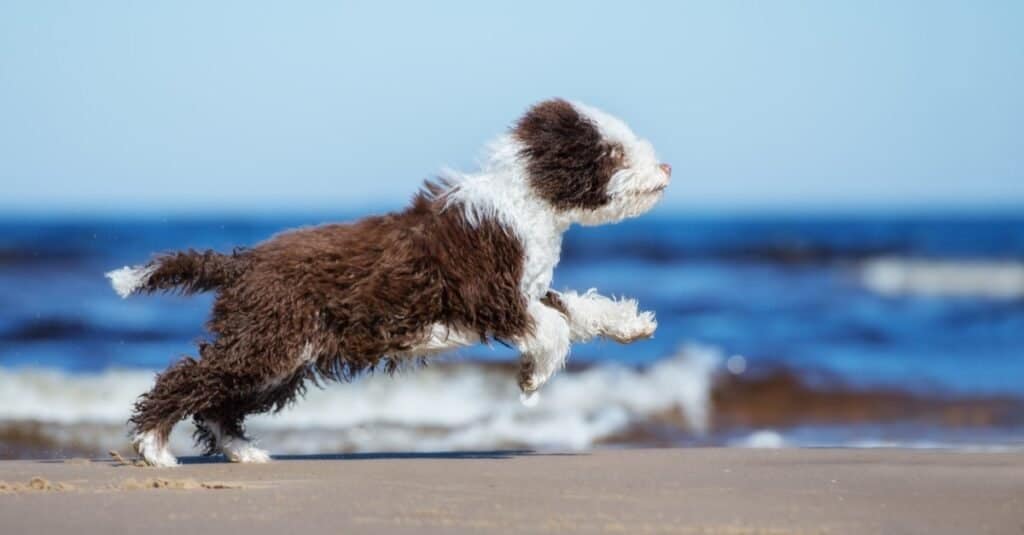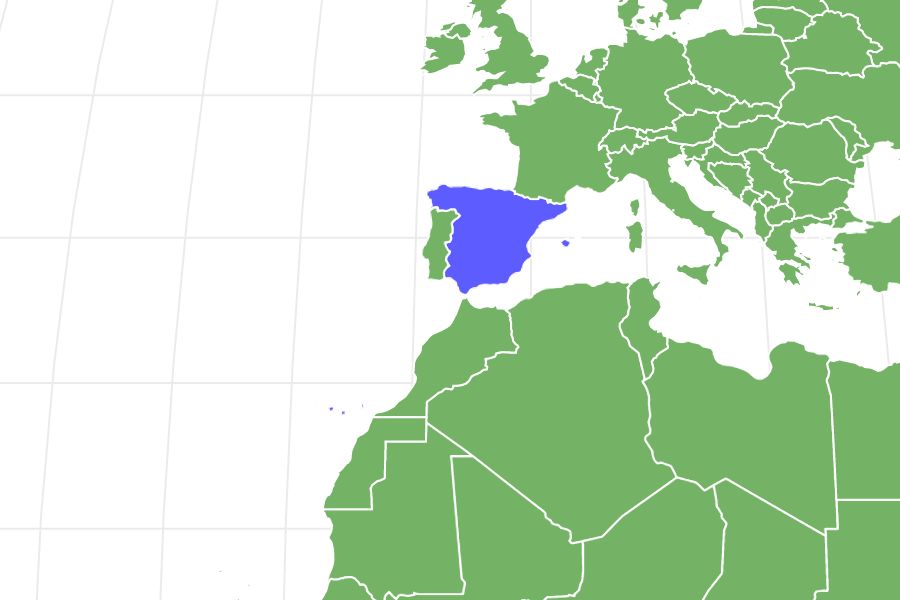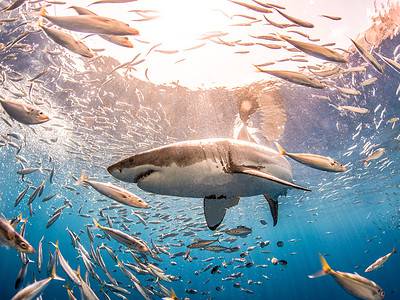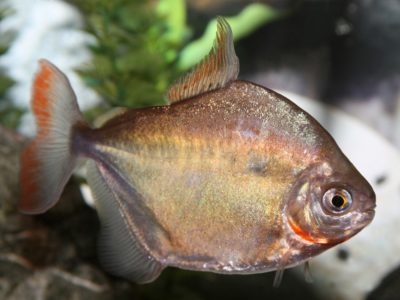Spanish Water Dog
Canis lupus familiaris
Spanish water dogs are popular with fishermen and hunters to retrieve game from the water.
Advertisement
Spanish Water Dog Scientific Classification
- Kingdom
- Animalia
- Phylum
- Chordata
- Class
- Mammalia
- Order
- Carnivora
- Family
- Canidae
- Genus
- Canis
- Scientific Name
- Canis lupus familiaris
Read our Complete Guide to Classification of Animals.
Spanish Water Dog Conservation Status
Spanish Water Dog Facts
Spanish Water Dog Physical Characteristics
- Color
- Brown
- Black
- White
- Beige
- Multi-colored
Spanish Water Dog as a Pet:
- General Health
- Energy Level
- Shedability
- Trainability
- Intelligence
- Tendency to Chew
- Size
- Family and kid friendliness
- Yappiness / Barking
- Moderate
- Separation Anxiety
- Low
- Preferred Temperature
- Average climate
- Exercise Needs
- High
- Friendly With Other Dogs
- Moderate
- Pure bred cost to own
- Initial purchase $1,500-$2,500. Food, medical, and upkeep: $650 a year.
- Dog group
- Herding
- Male weight
- 40-49 lbs
- Female weight
- 31-40 lbs
View all of the Spanish Water Dog images!
The Spanish water dog is a breed that was developed in Spain as a water retriever for fishermen and as a herding and guard dog for farmers. It is thought to be descended from African breeds brought to the Iberian Peninsula over 1,000 years ago. Spanish water dogs are medium-sized with adorable, long, curly hair that cascades down over their eyes and helps them thrive in the changeable climate of Spain. As companion pets, they are affectionate, trainable, and low maintenance. They get along well with children and household pets, but they do have strong herding instincts and need to be trained not to chase and nip too enthusiastically. This is a breed that is sure to bring delight to your family and spark great interest from people you meet on the street with its friendliness and attractive appearance.
3 Pros and Cons of Owning a Spanish Water Dog
| Pros! | Cons! |
|---|---|
| Adapts well to small spaces. As a medium-sized dog, this breed can do fine in an apartment or small house. But they are energetic and need plenty of opportunities to run and play outdoors. | Very energetic. They are used to running and chasing in their natural environment, so they need lots of vigorous exercise. This should include both structured walks and unstructured play time. |
| Playful and kid-friendly! Spanish water dogs get along well with other pets and with children. They need to be taught not to nip or herd them too enthusiastically, however. | Nip and chew a lot. You’ll have to hide your shoes with this one. As puppies, they chew incessantly and enjoy nipping at pants legs and being dragged around the house. Provide them with toys and train them not to do what you don’t like. |
| Low maintenance grooming. The breed standard requires long, curly hair that is not shaved or over-groomed. Their hair will cord naturally as it grows. All that is required is occasional bathing. | Health issues. Spanish water dogs are prone to allergies, hip dysplasia, and other issues. Watch their diet and be prepared for regular veterinary checkups and medical treatments as they get older. |
The Best Dog Food for a Spanish Water Dog
It’s always important to provide your dog with high-quality food to keep them looking and feeling good. Spending a little more on a weekly basis on better food can save you and your companion a great deal of discomfort and much higher expenses later to treat preventable medical conditions.
See all of our expert product reviews.
Because they are prone to allergies and several potentially serious health conditions, A-Z Animals recommends Blue Buffalo Wilderness Protein Natural. It does not contain common food allergens like wheat, corn, soy, and poultry by-products. It has omega fatty acids to help your dog’s skin and coat stay healthy. Energetic dogs need a high level of protein. Blue Buffalo provides this from real chicken as well as a scientific blend of vitamins, minerals, and antioxidants to strengthen your little friend’s immune system. It’s a great brand, available for all stages of a dog’s healthy development.
Spanish Water Dog Size and Weight

Ranging between nearly 18 to 20 inches tall, Spanish water dogs are medium-sized dogs.
©otsphoto/Shutterstock.com
Spanish water dogs are medium-sized. Males range from 17.5 to 19.75 inches tall and can weigh 40 to 49 pounds. Females can be 15.75-18 inches tall and weigh anywhere from 31-40 pounds as adults.
| Height (Male) | 17.5-19.75” tall |
| Height (Female) | 15.75-18” tall |
| Weight (male) | 40-49 pounds, fully grown |
| Weight (female) | 31-40 pounds, fully grown |
Spanish Water Dog Common Health Issues
The Spanish water dog has a reasonably long life expectancy of 12-14 years. However, a number of different health problems have been found in the breed. Owners need to feed their dog a high-quality dog food and make sure they have regular testing at the vet to catch any of these issues early on when there may be more treatment options. Below is a list of possible health issues your dog may encounter:
Health and Entertainment for your Spanish Water Dog
- Royal Canin Bulldog Dog Food Review: Pros, Cons, Recalls
- Best Dog Food for Dogs With Diarrhea (Senior, Adult, and Puppy) — Reviewed and Ranked
- These Are the Best Probiotics for Dogs (They Actually Work)
- The Best Treatments for Car Sick Dogs
- The Best Dog Food for Labrador Retrievers (Senior, Puppy, and Adult)
See all of our expert product reviews.
- Hip dysplasia[3]
- Progressive retinal atrophy (prcd-PRA)
- Hypothyroidism
- Hypoadrenocorticism (also known as Addison’s disease)
- Exocrine pancreatic insufficiency
- Allergies
- Cataracts
- Congenital hypothyroidism with goiter (CHG)
- Distichia
- Cherry eye
- Neuroaxonal dystrophy
Spanish Water Dog Temperament and Behavior
Spanish water dogs are energetic, playful, and affectionate. Having been bred for retrieving game, herding, and guarding, they love playing games like catch and fetch or just zooming around the yard. Their natural herding instincts will come out with other animals and people, especially children. They will enthusiastically chase things that run and nip at their heels to herd them in a different direction. This behavior can be curbed with early socialization and positive training. They can be wary around strangers—a good behavior in a guard dog—but will warm up as they get to know the person.
How to Take Care of a Spanish Water Dog
Spanish Water Dog Maintenance And Grooming
As water dogs, this breed doesn’t mind a bath as much as other dogs do. But it only needs bathing every 3-4 weeks, depending on your family’s lifestyle and how messy the dog’s outdoor play environment has been.
Spanish water dogs have a long, wooly, curly coat with no undercoat. It comes in solid black, beige, white, or brown or two colors mixed. They shed minimally and their fur will grow naturally into cords or dreadlocks. The breed standard is to allow the coat to grow and have a natural look, not to clip it or groom it for aesthetic reasons. Although the coat should not be trimmed, it should be sheard down once a year for a fresh start that will eliminate any tangles or mats that have developed.
Spanish Water Dog Training
Spanish water dogs are highly trainable and need to be trained from puppyhood to channel their natural instincts in ways that are well-mannered and acceptable in your family. Don’t fall into the trap of letting them get away with undesirable behavior because it is cute. Behaviors become increasingly difficult to correct the longer you tolerate them. Training should not be harsh. These dogs are intelligent and eager to please. The best training is to reward positive behavior rather than punish negative behavior. When the pup does something you don’t like, substitute a different behavior, such as giving him a toy when he tries to chew your shoe.
Your dog will likely try to herd your children and your other pets by circling and nipping. With children, this needs to be stopped immediately. The dog should be firmly corrected, removed from the child, and given an activity such as a game of fetch to distract him.
This breed should always be kept on a leash when not in a fenced enclosure. They are curious and smart, so they may try to jump over, climb, or dig under fences and can fit through small openings. Some homeowners prefer invisible fencing, but this does not stop other animals from coming into your yard, or your animal from breaking through if he is determined enough.
Spanish Water Dog Exercise
Spanish water dogs require a great deal of exercise, including daily walks and playtime in a fenced yard. They are highly social and prefer to be with you, but can entertain themselves for some time alone in the yard. Just keep an eye out that they’re not working on an escape plot! They enjoy having a job to do that is both physically and mentally stimulating. Catch, fetch, flying disc, and agility tasks are all activities they will enjoy. If you want a sedentary dog, this is not the dog for you!
Spanish Water Dogs and Children
Spanish water dogs do quite well with children when trained and socialized at an early age. Teach your children not to tease or hit the dog and what to do when the dog is playing too roughly. Train you pet not to chase or nip at your child. Adults should always supervise small children around dogs, especially an energetic herding breed such as this. Older children need to be included in the training regimen for your dog, to help them bond, provide consistency for the animal with various family members, and spread out the task of burning off this dog’s incredible stores of energy.
Dogs Similar to the Spanish Water Dog
- Portuguese Water Dog — A very similar breed to the Spanish water dog. One difference is that they can have wavy or curly coats, whereas the Spanish water dog always has a curly coat.
- Poodle — Similar in size to the Spanish water dog with a curly coat, but requires much more grooming to stay in good condition. Of the two breeds, the poodle has a higher intelligence level.
- American Water Spaniel — This breed is smaller and cheaper to purchase and maintain than the Spanish water dog. It has less of an impulse to chase and catch prey than the Spanish water dog.
Popular Names for Spanish Water Dogs
Names for male Spanish water dogs include:
- Ollie
- Marco
- Ralphio
- Dewy
- Ewok
Names for female Spanish water dogs include:
- Cleo
- Joclinda
- Vivian
- Leia
- Sophie
Related Animals…
View all 292 animals that start with SSpanish Water Dog FAQs (Frequently Asked Questions)
How much does a Spanish water dog cost to own?
Spanish water dogs are somewhat of a rare breed. The initial purchase price of a puppy can be $1,500-$2,500. Food, medical care, and upkeep is approximately $650 a year.
Is the Spanish water dog good with kids?
Yes, they are protective and affectionate toward children. They have a high energy level so they can keep up with children’s play for a long time. They do have strong herding instincts, though, which means they may chase or nip at children as they run. They can be trained not to do this.
How long does a Spanish water dog live?
The life expectancy of a Spanish water dog is 12-14 years.
Thank you for reading! Have some feedback for us? Contact the AZ Animals editorial team.
Sources
- American Kennel Club / Accessed November 23, 2022
- Petnetid.com / Accessed November 23, 2022
- Wag! / Accessed November 23, 2022
- Wikipedia.com / Accessed November 23, 2022





















